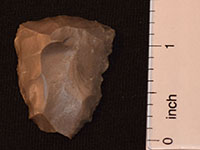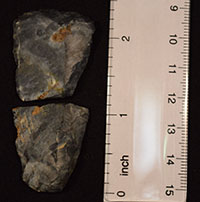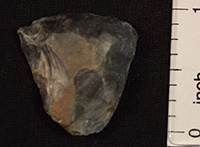
End scrapers are by far the most numerous formal tools at the Nobles Pond site. Over 1700 of them were recovered from the site. This is the second largest number of end scrapers of any recorded site in North America, exceeded only by the Debert site, in Nova Scotia, Canada.
What were the Paleoindians doing with all those end scrapers?
What Is an End Scraper?
An end scraper is a unifacial tool (that is, flaked on only one side), with a scraping bit worked on one end (sometimes referred to as the "distal" end). An end scraper can be used for various scraping tasks (for example, for hide scraping, wood working, or bone shaping).
At Nobles Pond, the most common type of end scraper is the trianguloid type, which is characteristic of the period between 13,000 to 10,000 years before present.
A trianguloid end scraper is typically attached to a handle (called a haft), made of wood, bone or antler. At Nobles Pond, the haft end of the end scraper (the "proximal" end) is typically tapered to fit into a socket or a notch in the haft.
End Scraper Manufacture
Most of the end scrapers recovered from the Nobles Pond site were made elsewhere and brought to the site for use. The cherts ("flints") used to make the end scrapers are roughly the same as those used to make the fluted points: half Upper Mercer and half Flint Ridge. There is also a small percentage of Attica, Wyandotte and other cherts.
Most Nobles Pond end scrapers were probably not a byproduct of fluted point production (as often occurs at fluted point sites in the southwestern U.S.), but likely resulted from their own, separate manufacturing path.
End Scraper Use
So, what were the Paleoindians doing with all those end scrapers? To determine the nature of the scraping done with these tools, we had edge-wear analysis and protein residue testing done on large samples of the tools.
Based on edge-wear analysis, hide-scraping was an important activity at the site. The end scrapers were used mostly for scraping wet, greasy, pliable hides (that is, fresh hides), with some dry-hide processing (stored hides), and some secondary use for woodworking and plant fiber processing.
Protein residue testing identified residues from a variety of animals. The most common animals identified were cervids (deer, elk, moose, caribou, stag-moose, or related: 12 hits) and rabbits/hares (8 hits). There was one specific identification of elk residue and two specific identifications of caribou.
These results suggest that the scraping of cervid hides (and possibly rabbit hides) was a major Paleoindian activity at Nobles Pond.
End Scraper Maintenance
Modern studies replicating hide scraping show that Paleoindian end scrapers are typically resharpened many times before being discarded. The large number of uniface resharpening flakes recovered from the site supports this idea.
Resharpening sometimes caused an end scraper to break between the bit and the haft. When this type of breakage occurred, a Paleoindian would sometimes salvage the tool by reshaping one or both pieces into new, smaller end scrapers.
End Scraper Afterlife: Recycling
At Nobles Pond, used-up end scrapers were often reshaped to use as other tools, especially gravers. Graver spurs could be worked onto one or both corners of an end scraper bit.
Discussion
It is not surprising to find a predominance of cervid residue on Paleoindian end scrapers. In particular, white-tailed deer and caribou would have provided Paleoindians with a lot of meat. In addition, their hides could be used for warm clothing (such as parkas), tent covers, snow-shoe webbing and more.
Rabbit residue has been frequently reported at other Paleoindian sites. Paleoindians might have used rabbit hides for clothing and meat, but rabbit sinews can also be used for lashing stone tools to hafts. Also, glue made from rabbit hides is useful in strengthening the bond between a stone tool and its haft.




